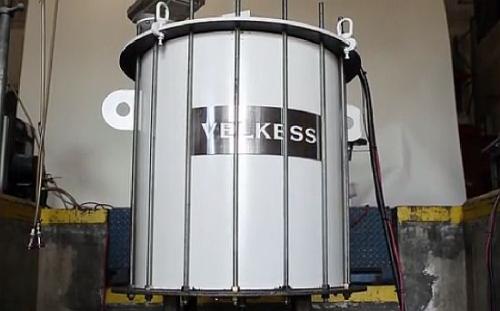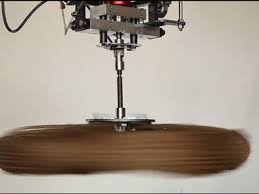The Velkess Flexible Flywheel promises energy storage technology at a “radically lower cost.” Think of a house with solar panels on the roof. During the day the house receives enough energy from the Sun to power the lights, heat, air conditioning and appliances in the house. Excess energy drives a flywheel which stores up the energy it receives by spinning faster and faster. The flywheel may be on its own or connected to additional power storage such as a chemical battery (lead acid, nickel cadmium, nickel metal hydride, nickel zinc or lithium ion. When the Sun sets the stored energy is released to power the house lights, heat, air conditioning and appliances throughout the night.
The flywheel on its own, rotating at thousands of RPMs can be the force driving the generator while releasing the kinetic energy it has stored during daylight. There are lots of myths about flywheels. Inventors talk about coming up with perpetual motion machines based on flywheels. But in fact the laws of thermodynamics in this Universe cannot easily be broken. Flywheels eventually slow down. So it may be helpful to understand exactly what the differences are between regular flywheels and the Velkess Flexible Flywheel, and why people on Kickstarter, the crowdsourcing funding site, have ponied up over $56,000 so far.
How a flywheel works is simple. Electrical energy is fed to the wheel which causes it to turn around a central axis. The wheel is mounted on low friction bearings. As it rotates it stores the energy it receives in kinetic form (that is in increasingly rapid rotation). The trick is to create a low friction coefficient so that minimal energy gets lost from the transfer of power to the wheel from the energy source. Once that energy source stops the flywheel continues to spin now discharging its stored kinetic energy through an attached spinning generator.
Now to the Velkess Kinetic Flywheel. What makes it different? Velkess stands for Very Large Kinetic Energy Storage System. The rotor is made of a form of flexible fiberglass called e-glass. The e-glass has properties that make it a suitable material choice. It is soft. It flexes like a lasso. This allows it to adjust to destablizing forces over the lifetime of operation. In addition the flywheel is mounted in a vacuum to reduce frictional energy loss even further.
On Kickstarter the inventor, Bill Gray, has asked for $54,000 to help him scale up the current working prototype (they claim to have made 50 to date). The prototype uses a 12 kilogram (25 pound) rotor. They want to build one that is 340 kilograms (750 pounds). He is convinced that once he scales up homes will be able to dispense with power from the grid and batteries, and run entirely off solar, wind and his invention.
Scaling up a flywheel is not easy. The bearings and magnets needed to safely operate the flywheel with a vastly increased weight load. At what speed would such a large flywheel become unstable? And what speeds would be needed to get desirable levels of kinetic energy stored that then could be released to operate a house full of appliances for a period of up to 15 hours over mid-latitude winter nights?
The Velkess Kinetic Flywheel, according to its inventor, will be cheaper than a battery based system over the life of its operation. How much that is doesn’t appear to be stated anywhere on the Kickstarter or company website.
As I stated in my title to this posting – is this real, wishful thinking or a hoax? We’ll keep following Bill Gray’s company and keep you informed.

















I don’t think it’s a hoax. The technical explanations they offer are at least consistent with the known laws of mechanics, For instance, schemes for storing energy kinetically are all hostage to the equation: Kinetic Energy equals 1/2 the mass times the square of the velocity. It matters not whether the velocity is linear or rotational. The kinetic energy stored in the flywheel increases with the square of the RPM, and linearly with the mass. So when Bill Gray says their 25-pound prototype stores 1/2 kWh and that a 750-pound production version would store 30 times as much (15 kWh), that’s numerically consistent with simple physics (assuming the same RPM that produces 1/2 kWh with the 25-pound wheel). But the Velkess presentation begs an obvious question: “Why not just spin the 25-pound flywheel 5.5 times as fast and store 30 times as much energy?
And therein lies the major fly in the flywheel ointment. The real breakthrough technology for flywheels is not how to balance them, suspend them, and make low cost low friction bearings, but rather extremely strong materials that can constantly and reliably resist the huge centrifugal forces. They can’t spin the 25-pound flywheel any faster without centrifugal forces explosively disassembling the wheel. That might be a moderate problem for a 25-pound wheel, but imagine the explosive disassembly of a 750-pound wheel. Think in terms of a suitcase nuke detonating in the basement. I just don’t see commercial viability.
Apparently Li-ion batteries could and should sell for about $1,000 kW. Catastrophic failures of 15 kWh banks of Li-ion batteries are nothing like suitcase nukes. I just don’t see how the 750-pound flywheel system sells for less than $15,000. So the batteries seem lighter, more compact, and safer. Unless Velkess has made some breakthrough in super strong materials, it doesn’t look like a good investment.
The argument for cost using Velkess over a battery storage solution is described in terms of savings over the lifetime of the product’s operational use. So one can argue that a battery has a finite existence of a few years before needing replacement whereas a flywheel if properly maintained can last “x” number of years spreading the costs. Without a price tag there is no way to know if the claim will prove true. And without an operational flywheel working “x” number of years there is no way to validate the savings that will be derived. In the meantime Panasonic is selling a home solar and battery storage system in the Asian and European markets. See https://www.21stcentech.com/energy-update-home-energy-storage-technology-commercial/.
Well, as best I can discover, a 750-pound flywheel that stores 15 kWh will likely spin at about 30,000 RPM. My 5,000 mph rim speed was perhaps somewhat of an exaggeration. More likely the rim speed would be closer to 3,000 mph, but still, the authorities will never license a 3,000 mph flywheel for above ground residential use. A good treatment of the basic physics of actual flywheels is given at: http://rpm2.8k.com/basics.htm
There is just no way to rediscover the flywheel. Batteries will beat it out in the market place. By the way, it makes sense to suppose Panasonic has heard of flywheels.
Theoretical longevity of flywheels just isn’t much of a bonus. The flywheel economics suffer from the same economic problem that permanent stainless steel residential roofs, siding, and plumbing do. No one wants to buy a permanent building to use for a temporary lifespan. In the US the average residence changes hands about ever seven years.
mv^2/2 = E
v^2= 2E/m
v2 = 15 * 3.6 million / 750
= 108 million. /750
= .144 million.
v = 144 m/sec
Now that’s the average speed, given the pics, the rim speed will be somewhat higher. Call it 200 m/sec or about 2/3 the speed of sound.
3,000mph isn’t an important measurement. The question is not of speed, but of KE. Something weighing more than a bullet but traveling slower will cause as much or more damage–think of a 300kg wrecking ball smashing into a house at 40mph, versus an 80g 9mm round at 580mph.
We use flywheels for continuous backup power storage in high-power operations such as keeping up data centers or 500kW television broadcast equipment. I’ve had my cubicle 8 feet from a window looking out into a picnic area, with a block wall separating me from the high-energy flywheel 4 feet away. That flywheel would turn that wall to fine asbestos dust if it went AWOL.
The Velkess website offers no pictures of prototypes, information of current stage of development and only superficial technical data. The phone number goes to a message box which is full and no message can be left. Emails are ignored and queries never answered. Velkess is registered in a private apartment in San Francisco. Is there a factory or even a lab? Who knows. The only changes on the website are the delivery dates pushed forward by another year. How far would $54,000 go for a project of this magnitude? To me, this smells of amateurism or even outright fraud. I don’t think they have got anything to show at all.
If it defies the laws of physics then it isn’t too difficult to assume it is a hoax. Remember Kickstarter isn’t about investment. It’s about giving a gift of money to someone who pitches an idea or product. My biggest concern about crowdfunding is the lack of rules that govern it.